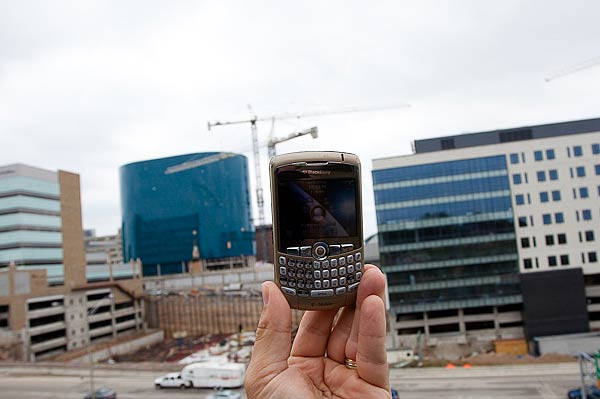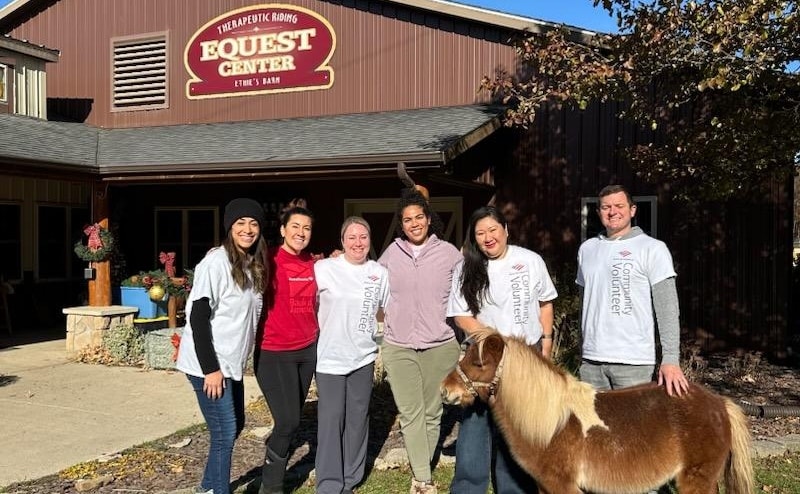Stretching the Medical Mile
Through the practice of telemedicine, West Michigan’s health care infrastructure is growing increasingly virtual, stretching the boundaries of the Medical Mile to the far reaches of the state.
The Medical Mile winding through the Hillside District of downtown Grand Rapids may have just gotten a whole lot longer through a new alliance of the healing arts and the information superhighway.
DeVos Children’s Hospital took its first steps this summer into telemedicine, an emerging field of medical practice that harnesses the information gathering power of cell phones, real-time video conferencing, even old fashioned telephone lines.
And it appears that Grand Rapids has a solid shot at entering this new field with the existing medical resources locally and the arrival of the Michigan State University’s school of human medicine in the near future.
Telemedicine already may have saved patients in Marquette several hours of driving time for checkups with Dr. Steven T. DeRoos, a specialist in pediatric neurology at DeVos Children’s Hospital.
Through the hospital’s partnership with Marquette General Health System , DeRoos was able to check up on patients more than 400 road miles away from his home office in Grand Rapids. Statewide, DeVos teams with 27 hospitals through a Partners in Children’s Health network.
“We’ve conducted a trial run of working with patients in Marquette and we’re exploring the options of expanding it in other areas,” says Anne Veltema, spokesperson for DeVos Children’s Hospital . “This was the checkup (after initial in-person appointments) and they were able to do it remotely. He was seeing the patient on the screen and able to hear them and talk to them.
“There are places in medicine where this is appropriate. It’s more about the (patient’s) family and being able to provide Helen DeVos Children’s Hospital programs six, seven, eight hours away. It will save patients on having to drive from Marquette to Grand Rapids.”
No Limits
Telemedicine is “really only limited by the imagination, ” says Pamela Whitten, the newly named dean of MSU’s College of Communication Arts & Sciences and an expert in the field who addressed the subject this spring in Grand Rapids for a gathering of MSU alumni.
How efforts like this one affect the cost and quality of health care, and the feasibility of broader telemedicine application, is Whitten’s job. Promoted last week to college dean at MSU, Whitten in the 1990s ran a telemedicine program at the University of Kansas Medical Center . She now does research on telemedicine, which is being used in everything from psychiatry to cardiology to dermatology in places like nursing homes, prisons and schools.
At a Lansing middle school, for example, MSU child psychiatrist Paul Quinlan has video appointments with low-income students in the nurse’s office. One of Whitten’s newest projects is a National Institutes of Health-funded grant for using telemedicine to assess depression in patients of rural cancer clinics. In another study, patients submitted personal health details by texting on their mobile phones.
“(The cell phone) is an imbedded technology and it really transcends socioeconomic status as well. It was easy for them to send in their daily readings,” Whitten says. “We try cutting-edge applications and see how they work and hope that they’ll eventually be deployed.”
“Not only are they (in Marquette) leading Michigan, but they are in some ways leading the nation,” Whitten says. “Back in the early ‘90s when nobody was doing this, the (Upper Peninsula) rolled their sleeves up. And it makes sense. There’s such a need up there. In addition to the need, they were innovative and bold.”
At her presentation in Grand Rapids , Whitten highlighted some of what Marquette is doing with home health, dialysis, bariatric care and other services through the Upper Peninsula Telehealth Network of Michigan.
The rural quality of the Upper Peninsula cuts to the heart of telemedicine, as Whitten sees it: Improving access to a full range of health services. For example, if there are no pediatric neurologists in Marquette, then link patients to specialists in Grand Rapids using telecommunications.
“The bottom line is you’re enhancing quality of life in general if you’re enhancing health care services,” Whitten says. And in some cases, “when you improve care, you reduce costs.”
Potenital Opportunities
Though she has no current research projects in the Grand Rapids area, Whitten says existing medical resources locally and the arrival of MSU’s medical school give the region a great opportunity to utilize telemedicine.
One growing telemedicine field with a goal to safeguard health and save money is remote monitoring of patients. Whitten evaluated a project in Indiana that had congestive heart failure patients plugging into their home phone lines devices that each day would ask questions and take weight and blood pressure readings. The data was sent into the patient’s electronic medical record and, if any responses registered abnormal, a nurse was notified.
Her research found that the patients in the study experienced physical, emotional and behavioral improvements.
“If someone has a chronic health problem and you are able to employ remote health monitoring, you’re going to find out sooner rather than later if something’s out of whack,” Whitten says. “The goals of the monitoring are to keep people out of hospitals.
“There’s really great potential for increasing health care access in that way. We’re really poised to grow.”
Among the obstacles to broader use of telemedicine are health care providers themselves, Whitten told alumni. She says that’s understandable for doctors always on the run with a waiting room full of patients, as there may be little time for a learning curve associated with telemedicine.
Still, the reluctance is a point of Whitten’s study. After all, the concept offers benefits to providers, perhaps the biggest of which is a time savings. In the DeVos Children’s Hospital pilot, DeRoos saw a half-day’s worth of patients in about the same time it takes to hop a one-way flight to Marquette, and in about half the time it takes to drive. And he did it from a conference room in Grand Rapids.
“They can walk in one room and see a patient live and then walk in the next room and do it remotely,” Whitten says. “They certainly could have their own life be more convenient. They certainly could have access to new client base.”
The technology has sparked a scattered surge of Web applications enabling things like online doctor visits for consultations on minor illnesses. Now, with federal stimulus money targeted for broadband Internet access and medical technology, the time may be right for a macro-scale transition in Michigan health care.
In fact, it was former President Clinton’s health reform effort that launched a renaissance of telemedicine in the early 1990s, says Whitten, who was then at Kansas. “Originally,” she says, “it was pretty much video conferencing in real time.” Now, videophones are used to provide Hospice care, bedside robots monitor stroke patients and various scopes are available so “you can look in any orifice you want” from long distance, Whitten says.
“It just kind of grew and grew and expanded in terms of its concept,” Whitten says. “It has morphed. There is no simple or single model. The sky’s the limit.”
Matt Vande Bunte writes about business, government, religion and other things. His work has appeared in newspapers including The Grand Rapids Press and Chicago Tribune and in assorted sectors of cyberspace.











